Surface Roughness Analysis and Prediction with an Artificial Neural Network Model for Dry Milling of Co–Cr Biomedical Alloys
Abstract
:1. Introduction
2. Materials and Methods
2.1. Materials Characterization
2.2. Cutting Experiment Setup
2.2.1. Milling Equipment Description and Experimental Conditions
2.2.2. Cutting Parameters and Experimental Plan
2.2.3. Samples Preparation
2.2.4. Roughness Measurement Equipment and Procedure
3. Results and Discussion
3.1. Results Presentation
3.2. Prediction Model Development
+ 22.1355978517912∗fz − 0.0172205349781354∗vc
+ 18.6487680467611∗fz + 0.00916261206257762∗vc
+ 1.855399∗ap2 + 40.42375∗fz2 + 0.002083401∗vc2 − 3.427583∗ap∗fz
− 0.04793371∗ ap∗vc − 0.9592412∗fz∗vc
+ 0.8959987∗ap2 + 454.1539∗fz2 − 0.0001372941∗vc2 − 37.3593∗ap∗fz
+ 0.02708041∗ ap∗vc + 1.132445∗fz∗vc
3.2.1. Artificial Neural Network (ANN)
3.2.2. ANN Application Software for Prediction of Surface Roughness
- Max epocs: 8000–20,000;
- Error goal: 0.2–0.1;
- Max time (s): 15–40 s;
- Error evaluation: over both sets; and
- Vectors per iteration: 200–400.
3.2.3. ANN Analysis and Prediction
- ap (mm): maximum limit was extended from 0.75 mm to 1 mm;
- fz (mm/tooth): maximum limit was extended from 0.05 to 0.08;
- vc (m/min): maximum limit was not extended.
4. Conclusions
- The obtained experimental data shows that the Ra values that can be obtained by dry end-milling with an AlTiCrSiN PVD coated tool for Co–28Cr–6Mo and Co–20Cr–15W–10Ni alloys used in biomedical applications are under 2 μm. Consequently, the finishing operation necessary to obtain the final surface quality will have a smaller cost generated by a shorter processing time and, implicitly, a lower usage of the finishing cutting tool.
- When maintaining two of the considered process variables at a constant value, it can be observed that the Ra values obtained for machining Co–20Cr–15W–10Ni were predominantly smaller than those obtained for Co–28Cr–6Mo.
- The results obtained via regression analysis models for both alloys indicated less accurate prediction of Ra compared with the ANN models.
- The comparison of the measured results to the results originating from the numerical simulation indicated that the ANN model allows for the accurate estimation of the roughness value of the surface processed by milling, consequently becoming a valuable tool for technical applications. The generation of several ANN architectures with high prediction performance may lead to further studies and research efforts, which may include other process parameters and may help in establishing a correlation between machining processes and the processing requirements of the medical implants.
- Developing customized software for the prediction of Ra based on ANNs could be a development path to investigate for a future generation of applications which could assist the design process of implants for medical applications. Increasing the number of relevant input process parameters to the ANN may increase the accuracy of the predicted answer for Ra.
- To obtain an Ra value of less than 2 μm for the Co–20Cr–15W–10Ni or Co–28Cr–6Mo alloys, the study showed that the axial depth of cut ap should not exceed 0.75 mm, the feed per tooth fz should be 0.07 mm/tooth and 0.08 mm/tooth and the vc should be 20, 24.5, or 30 m/min.
- The presented results are in line with the concept of vertical integration, applying Industry 4.0 concepts and principles and may lead to new directions for developing useful ANN submodule tools which can assist the concept designing process of future medical implants based on biomedical alloys.
Author Contributions
Funding
Institutional Review Board Statement
Informed Consent Statement
Data Availability Statement
Acknowledgments
Conflicts of Interest
References
- Chen, Q.; Thouas, G.A. Metallic implant biomaterials. Mater. Sci. Eng. R Rep. 2015, 87, 1–57. [Google Scholar]
- Park, J.; Lakes, R.S. Biomaterials—An Introduction; Springer: New York, NY, USA, 2007; pp. 99–137. [Google Scholar]
- Santhosh, K.S.; Somashekhar, S.H. The Role of Surface Modification on Bacterial Adhesion of Bio-Implant Materials: Machining, Characterization, and Applications; CRC Press: Boca Raton, FL, USA, 2021; pp. 1–10. [Google Scholar]
- Milošev, I. CoCrMo alloy for biomedical applications. In Biomedical Applications. Modern Aspects of Electrochemistry; Djokić, S., Ed.; Springer: Boston, MA, USA, 2012; Volume 55, pp. 1–72. [Google Scholar]
- Mouritz, A.P. Superalloys for gas turbine engines. In Introduction to aerospace materials; Mouritz, A.P., Ed.; Woodhead Publishing: Cambridge, UK, 2012; pp. 251–267. [Google Scholar]
- Sumita, M.; Hanawa, T. Failure processes in biometallic materials. Bioengineering 2003, 9, 131–167. [Google Scholar]
- Vaicelyte, A.; Janssen, C.; Le Borgne, M.; Grosgogeat, B. Cobalt–Chromium Dental Alloys: Metal Exposures, Toxicological Risks, CMR Classification, and EU Regulatory Framework. Crystals 2020, 10, 1151. [Google Scholar]
- Geantă, V.; Voiculescu, I. Treaty of Obtaining of Biocompatible Metallic Materials [Tratat de Obținere a Materialelor Metalice Biocompatibile]; PRINTECH: Bucharest, Romania, 2018; pp. 97–115. [Google Scholar]
- Geantă, V.; Voiculescu, I.; Ştefănoiu, R.; Chiriță, I. Obtaining and characterization of biocompatible Co–Cr as cast alloys. Key Eng. Mater. 2015, 583, 16–21. [Google Scholar]
- Zaman, H.A.; Sharif, S.; Idris, M.H.; Kamarudin, A. Metallic biomaterials for medical implant applications: A review. Appl. Mech. Mater. 2015, 735, 19–25. [Google Scholar] [CrossRef]
- Zaman, H.A.; Sharif, S.; Kim, D.W.; Idris, M.H.; Suhaimi, M.A.; Tumurkhuyag, Z. Machinability of cobalt-based and cobalt chromium molybdenum alloys—A review. Procedia Manuf. 2017, 11, 563–570. [Google Scholar] [CrossRef]
- Constantin, G.; Balan, E.; Voiculescu, I.; Geanta, V.; Craciun, V. Cutting behavior of Al0.6CoCrFeNi high entropy alloy. Materials 2020, 13, 4181. [Google Scholar]
- Nandish, B.T.; Jayaprakash, K.; Shetty, H.K.; Rao, S.; Ginjupalli, K.; Chandrashekhar, H.R.; Prabhu, S. The effects of recasting on the cytotoxicity of dental base metal casting alloys. J. Conserv. Dent. 2020, 23, 412–416. [Google Scholar] [PubMed]
- Black, J.T.; Kohser, R.A. DeGarmo’s Materials and Processes in Manufacturing, 12th ed.; John Wiley & Sons: Hoboken, NJ, USA, 2019; p. 46. [Google Scholar]
- Dijmărescu, M.R.; Tiriplică, P.G. Development of cutting forces and surface roughness prediction models for turning a CoCrWNi alloy. MSF 2019, 957, 148–155. [Google Scholar] [CrossRef]
- Khorasani, A.M.; Gibson, I.; Goldberg, M.; Nomani, J.; Littlefair, G. Machinability of Metallic and Ceramic Biomaterials: A review. Sci. Adv. Mater. 2016, 8, 1491–1511. [Google Scholar]
- Bruschi, S.; Ghiotti, A.; Bordin, A. Effect of the process parameters on the machinability characteristics of a CoCrMo alloy. Key Eng. Mater. 2013, 554–557, 1976–1983. [Google Scholar] [CrossRef]
- Jackson, M.J.; Novakov, T.; Da Silva, M.B. Modeling and machining of medical materials. In Machining with Nanomaterials; Jackson, M.J., Morrell, J.S., Eds.; Springer International Publishing: Cham, Switzerland, 2015; pp. 231–271. [Google Scholar]
- Saravanan, R.; Hamidon, R.; Murad, N.M.; Zailani, Z.A. Machining of cobalt chromium molybdenum (CoCrMo) alloys: A review. In Intelligent Manufacturing and Mechatronics. Lecture Notes in Mechanical Engineering; Bahari, M.S., Harun, A., Zainal Abidin, Z., Hamidon, R., Zakaria, S., Eds.; Springer: Singapore, 2021; pp. 413–424. [Google Scholar]
- Meijer, A.; Bergmann, J.A.; Krebs, E.; Biermann, D.; Wiederkehr, P. Analytical and simulation-based prediction of surface roughness for micromilling hardened HSS. J. Manuf. Mater. Process. 2019, 3, 70. [Google Scholar] [CrossRef] [Green Version]
- Öktem, H. An integrated study of surface roughness for modelling and optimization of cutting parameters during end milling operation. Int. J. Adv. Manuf. Technol. 2009, 43, 852–861. [Google Scholar] [CrossRef]
- M’Saoubi, R.; Outeiro, J.C.; Chandrasekaran, H.; Dillon, O.W.; Jawahir, I.S. A review of surface integrity in machining and its impact on functional performance and life of machined products. Int. J. Sustain. Manuf. 2008, 1, 203–236. [Google Scholar] [CrossRef]
- Grzenda, M.; Bustillo, A.; Quintana, G.; Ciurana, J. Improvement of surface roughness models for face milling operations through dimensionality reduction. Integr. Comput. Aided Eng. 2012, 19, 179–197. [Google Scholar] [CrossRef]
- Mahesh, G.; Muthu, S.; Devadasan, S.R. Prediction of surface roughness of end milling operation using genetic algorithm. Int. J. Adv. Manuf. Technol. 2015, 77, 369–381. [Google Scholar] [CrossRef]
- Popovici, T.D.; Dijmărescu, M.R. Influence of cutting data on surface quality when machining 17-4 PH stainless steel. IOP Conf. Series Mat. Sci. Eng. 2017, 227, 012101. [Google Scholar] [CrossRef] [Green Version]
- Altas, E.; Gokkaya, H.; Ozkan, D. Investigation of the effects of machining parameters on tool life and surface roughness during the face milling of the niti shape memory alloy with uncoated tools. Preprints 2020, 2020080383. [Google Scholar]
- Novaes, A.B.; Souza, S.L.S.; Barros, R.R.M.; Pereira, K.K.Y.; Iezzi, G.; Piattelli, A. Influence of implant surfaces on osseointegration. Braz. Dent. J. 2010, 21, 471–481. [Google Scholar] [CrossRef] [PubMed]
- Zhang, M. Biocompatibility of materials. In Biomaterials and Tissue Engineering; Shi, D., Ed.; Springer: Berlin/Heidelberg, Germany, 2004; pp. 83–143. [Google Scholar]
- Velasco, E.; Monsalve-Guil, L.; Jimenez, A.; Ortiz, I.; Moreno-Muñoz, J.; Nuñez-Marquez, E.; Pegueroles, M.; Pérez, R.A.; Gil, F.J. Importance of the roughness and residual stresses of dental implants on fatigue and osseointegration behavior. In vivo study in rabbits. J. Oral. Implantol. 2016, 42, 469–476. [Google Scholar] [CrossRef]
- Wennerberg, A.; Albrektsson, T. Implant surfaces beyond micron roughness. Experimental and clinical knowledge of surface topography and surface chemistry. Int. Dent. SA 2006, 8, 14–18. [Google Scholar]
- Lohberger, B.; Eck, N.; Glaenzer, D.; Lichtenegger, H.; Ploszczanski, L.; Leithner, A. Cobalt Chromium molybdenum surface modifications alter the osteogenic differentiation potential of human mesenchymal stem cells. Materials 2020, 13, 4292. [Google Scholar] [CrossRef] [PubMed]
- Lohberger, B.; Stuendl, N.; Glaenzer, D.; Rinner, B.; Donohue, N.; Lichtenegger, H.C.; Ploszczanski, L.; Leithner, A. CoCrMo surface modifications affect biocompatibility, adhesion, and inflammation in human osteoblasts. Sci. Rep. 2020, 10, 1682. [Google Scholar] [CrossRef]
- Zain, A.M.; Haron, H.; Sharif, S. Prediction of surface roughness in the end milling machining using Artificial Neural Network. Expert Syst. Appl. 2010, 37, 1755–1768. [Google Scholar] [CrossRef]
- Souza, M.M.; Trommer, R.M.; Maru, M.M.; Roesler, C.R.M.; Barros, W.S.; Dutra, D.S. Surface evaluation of orthopedic hip implants marketed in Brazil. J. Phys. Conf. Ser. 2016, 733, 012034. [Google Scholar] [CrossRef]
- Rama, K.A.; Ginjupalli, K.; Upadhya, N.; Shammas, M.; Rama, K.R.; Sekhar, R. Surface roughness of implants: A review. Trends Biomater. Artif. Organs 2011, 25, 112–118. [Google Scholar]
- Sing, S.L.; Huang, S.; Yeong, W.I. Effect of solution heat treatment on microstructure and mechanical properties of laser powder bed fusion produced cobalt-28chromium-6molybdenum. Mater. Sci. Eng. A 2020, 769, 138511. [Google Scholar]
- Okazaki, Y. Effects of fine microstructures and precipitates of laser-sintered Co–28Cr–6Mo alloy femoral components on wear rate of UHMWPE inserts in a knee joint simulator. J. Mech. Behav. Biomed. Mater. 2020, 112, 103998. [Google Scholar] [CrossRef]
- Karimi, S.; Nickchi, T.; Alfantazi, A.M. Long-term corrosion investigation of AISI 316L, Co–28Cr–6Mo, and Ti–6Al–4V alloys in simulated body solutions. Appl. Surf. Sci. 2012, 258, 6087–6096. [Google Scholar]
- Okazaki, Y.; Ishino, A.; Higuchi, S. Chemical, Physical, and mechanical properties and microstructures of laser-sintered Co–25Cr–5Mo–5W (SP2) and W–Free Co–28Cr–6Mo alloys for dental applications. Materials 2019, 12, 4039. [Google Scholar] [CrossRef] [PubMed] [Green Version]
- Minciună, M.G.; Vizureanu, P.; Geantă, V.; Voiculescu, I.; Sandu, A.V.; Achiței, D.C.; Vitalariu, A.M. Effect of Si on the mechanical properties of biomedical CoCrMo alloy. Rev. Chim. 2015, 66, 891–894. [Google Scholar]
- Almanza-Casas, E.; Pérez-López, M.J.; Rodríguez-Rosales, N.A. Effect of heat treatment on the corrosion resistance in a Co–28Cr–6Mo alloy casting for surgical implants. Inter. Metalcast. 2018, 12, 71–78. [Google Scholar] [CrossRef]
- Wang, R.; Wang, R.; Chen, D.; Qin, G.; Zhang, E. Novel CoCrWNi alloys with Cu addition: Microstructure, mechanical properties, corrosion properties and biocompatibility. J. Alloys Compd. 2020, 824, 153924. [Google Scholar] [CrossRef]
- Ueki, K.; Yanagihara, S.; Ueda, K.; Nakai, M.; Nakano, T.; Narushima, T. Improvement of mechanical properties by microstructural evolution of biomedical Co–Cr–W–Ni alloys with the addition of Mn and Si. Mater. Trans. 2021, 62, 229–238. [Google Scholar] [CrossRef]
- Li, C.-L.; Oh, J.M.; Choi, S.-W.; Hong, J.-K.; Yeom, J.-T.; Mei, X.-M.; Mei, Q.; Yu, Z.; Park, C.H. Study on microstructure and mechanical property of a biomedical Co-20Cr-15W-10Ni alloy during multi-pass thermomechanical processing. Mater. Sci. Eng. A 2020, 785, 139388. [Google Scholar] [CrossRef]
- Ueki, K.; Ueda, K.; Nakai, M.; Nakano, T.; Narushima, T. Microstructural changes during plastic deformation and corrosion properties of biomedical Co-20Cr-15W-10Ni alloy heat-treated at 873 K. Metall. Mater. Trans. A 2018, 49, 2393–2404. [Google Scholar]
- Chang, H.K.; Kim, J.H.; Kim, I.H.; Jang, D.Y.; Han, D.C. In-process surface roughness prediction using displacement signals from spindle motion. Int. J. Mach. Tools Manuf. 2007, 47, 1021–1026. [Google Scholar] [CrossRef]
- Samhouri, M.S.; Surgenor, B.W. Surface roughness in grinding: On-line prediction with adaptive neuro-fuzzy inference system. Trans. NAMRI/SME 2005, 33, 57–64. [Google Scholar]
- Colak, O.; Kurbanoglu, C.; Kayacan, M.C. Milling surface roughness prediction using evolutionary programming methods. Mater. Des. 2007, 28, 657–666. [Google Scholar] [CrossRef]
- Lo, S.P. An adaptive-network based fuzzy inference system for prediction of workpiece surface roughness in end milling. J. Mater. Process. Technol. 2003, 142, 665–675. [Google Scholar] [CrossRef]
- Kumanan, S.; Jesuthanam, C.P.; Ashok Kumar, R. Application of multiple regression and adaptive neuro fuzzy inference system for the prediction of surface roughness. Int. J. Adv. Manuf. Technol. 2008, 35, 778–788. [Google Scholar] [CrossRef]
- Dijmarescu, M.R.; Dijmarescu, M.C.; Voiculescu, I.; Popovici, T.D.; Tarba, I.C. Study on the influence of cutting parameters on surface quality when machining a CoCrMo alloy. IOP Conf. Ser. Mater. Sci. Eng. 2018, 400, 0220206. [Google Scholar] [CrossRef] [Green Version]
- Wojciechowski, S.; Wiackiewicz, M.; Krolczyk, G.M. Study on metrological relations between instant tool displacements and surface roughness during precise ball end milling. Measurement 2018, 129, 686–694. [Google Scholar]
- Mia, M.; Królczyk, G.; Maruda, R.; Wojciechowski, S. Intelligent Optimization of hard-turning parameters using evolutionary algorithms for smart manufacturing. Materials 2019, 12, 879. [Google Scholar] [CrossRef] [PubMed] [Green Version]
- Zhou, G.; Xu, C.; Ma, Y.; Wang, X.-H.; Feng, P.-F.; Zhang, M. Prediction and control of surface roughness for the milling of Al/SiC metal matrix composites based on neural networks. Adv. Manuf. 2020, 8, 486–507. [Google Scholar]
- Bozdemir, M. Prediction of surface roughness considering cutting parameters and humidity condition in end milling of polyamide materials. Comput. Intell. Neurosci. 2018, 2018, 5850432. [Google Scholar]
- Lytvynenko, I.V.; Maruschak, P.O.; Lupenko, S.A. Processing and modeling of ordered relief at the surface of heat resistant steels after laser irradiation as a cyclic random process. Aut. Control Comp. Sci. 2014, 48, 1–9. [Google Scholar]
- Erzurumlu, T.; Oktem, H. Comparison of response surface model with neural network in determining the surface quality of moulded parts. Mater. Des. 2007, 28, 459–465. [Google Scholar] [CrossRef]
- Caramihai, M.; Severin, I. Enzyme production modeling simulation using neural techniques. Int. J. Biol. Biomed. 2018, 3, 26–29. [Google Scholar]
- Ravichander, B.B.; Rahimzadeh, A.; Farhang, B.; Shayesteh Moghaddam, N.; Amerinatanzi, A.; Mehrpouya, M. A Prediction model for additive manufacturing of inconel 718 superalloy. Appl. Sci. 2021, 11, 8010. [Google Scholar] [CrossRef]
- Haykin, S. Neural Networks: A Comprehensive Foundation, 2nd ed.; Prentice Hall: Hoboken, NJ, USA, 1999. [Google Scholar]
- Luk, K.C.; Ball, J.E.; Sharma, A. A study of optimal model lag and spatial inputs to artificial neural network for rainfall forecasting. J. Hydrol. 2000, 227, 56–65. [Google Scholar]
- Riedmiller, M.; Braun, H. A direct adaptive method for faster backpropagation learning: The Rprop algorithm. Proc. Int. Jt. Conf. Neural Netw. 1993, 1, 586–591. [Google Scholar]
- NI Super Simple Neural Networks by NI. Available online: https://www.vipm.io/package/ni_lib_super_simple_n_net/ (accessed on 12 September 2021).
- Wang, H.; Li, D.; Dong, S. Surface roughness prediction model for ultra-precision turning aluminum alloy with a single crystal diamond tool. Chin. J. Mech. Eng. 2002, 15, 153–156. [Google Scholar]



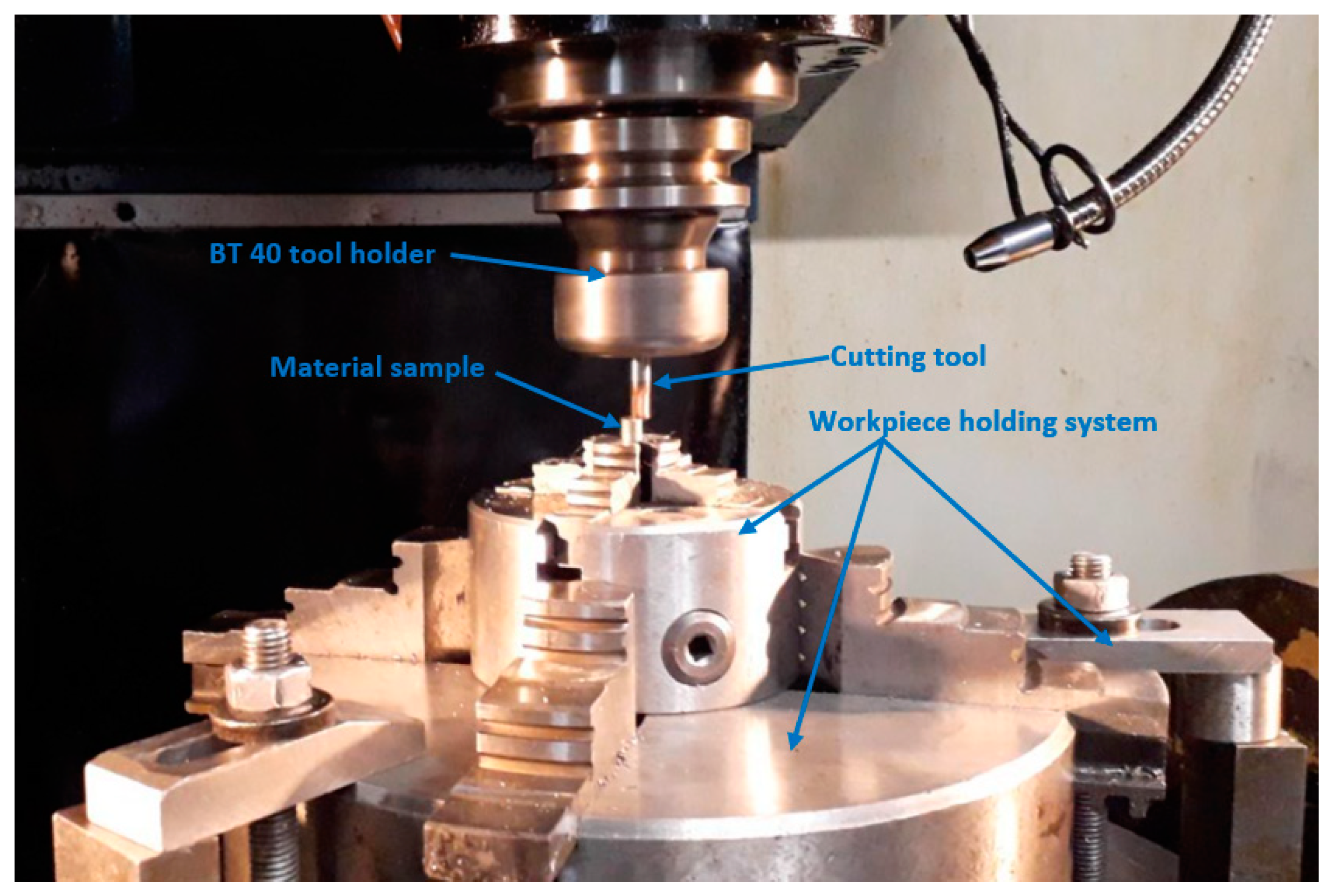


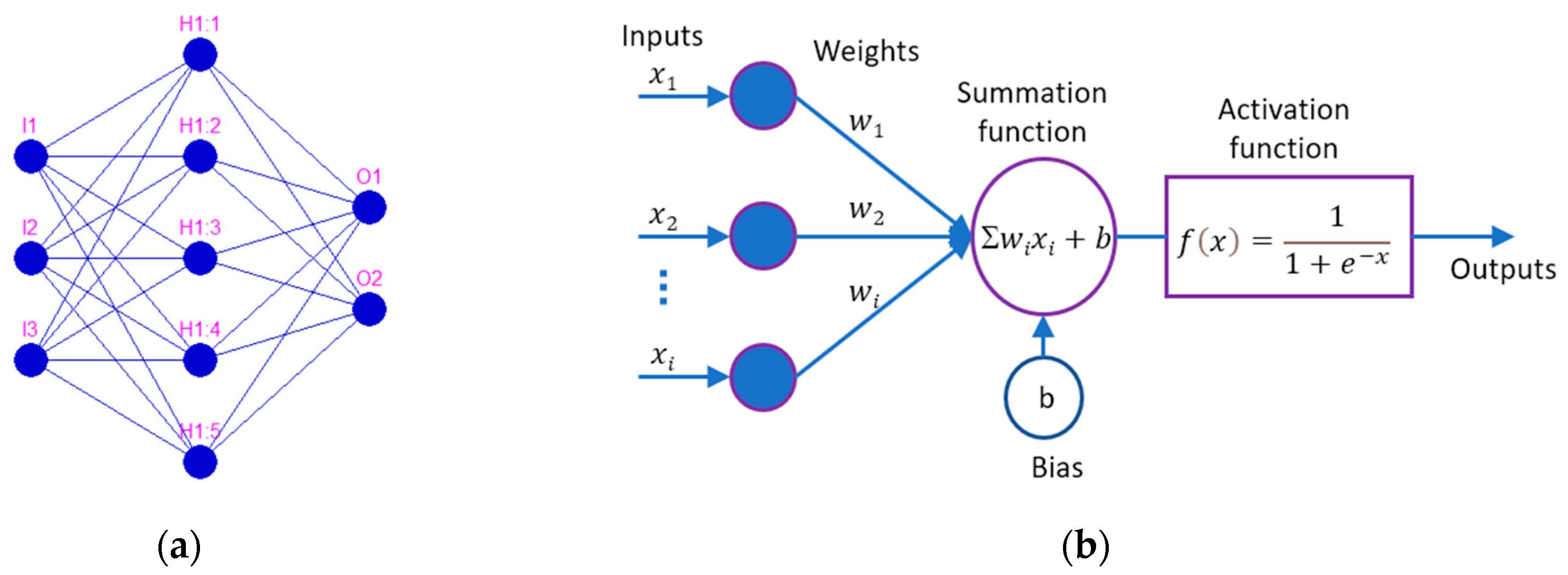



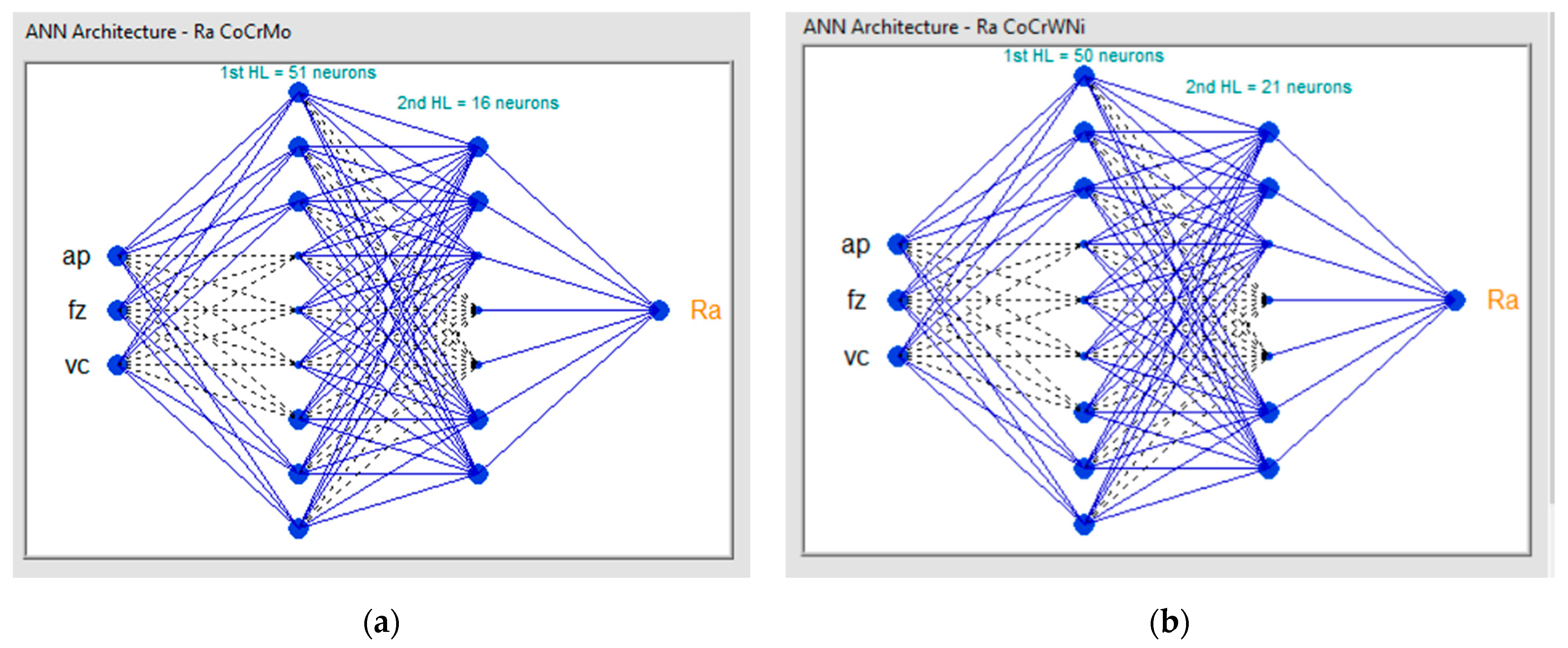
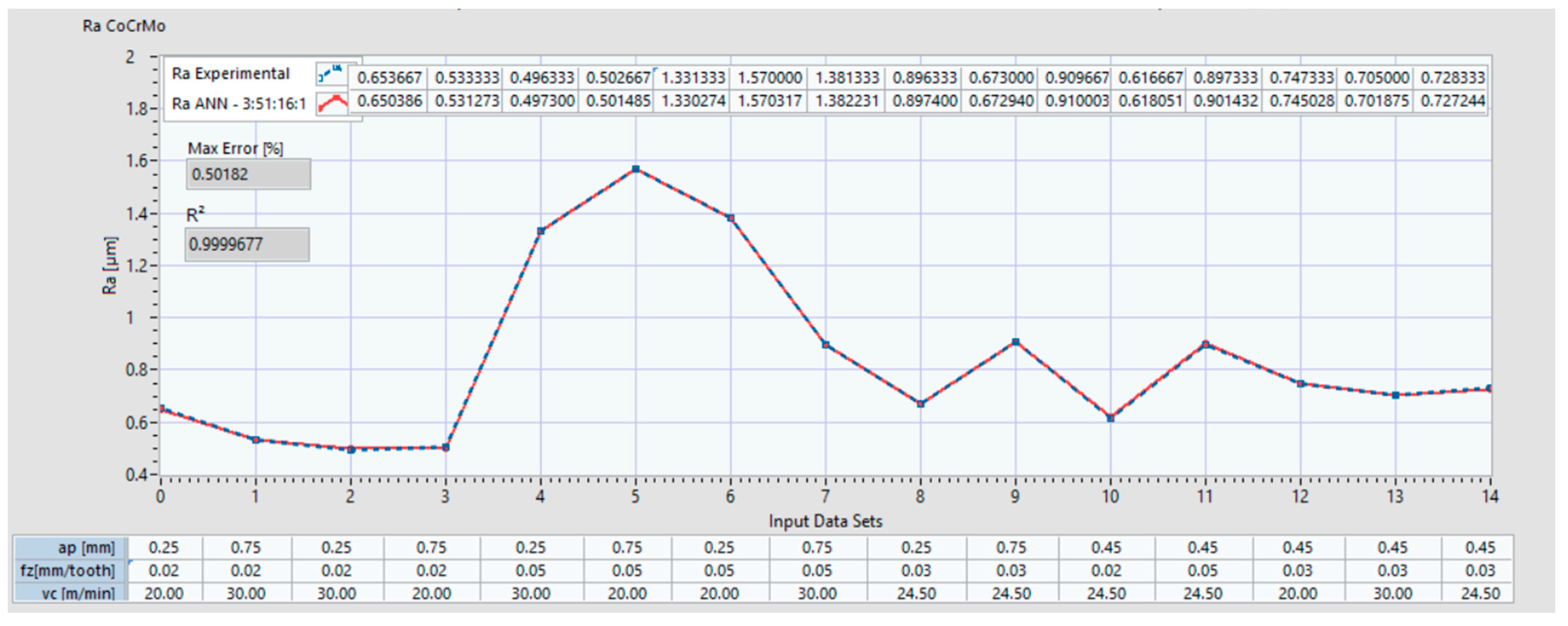
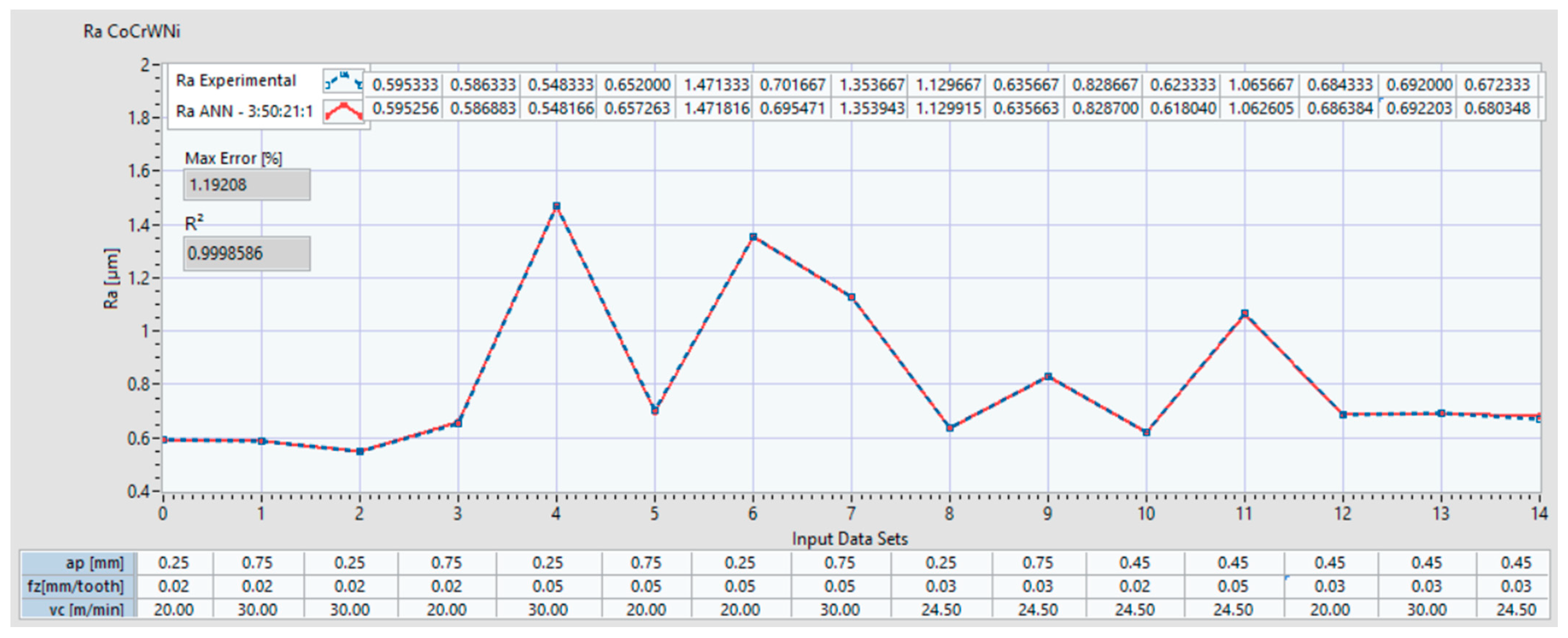
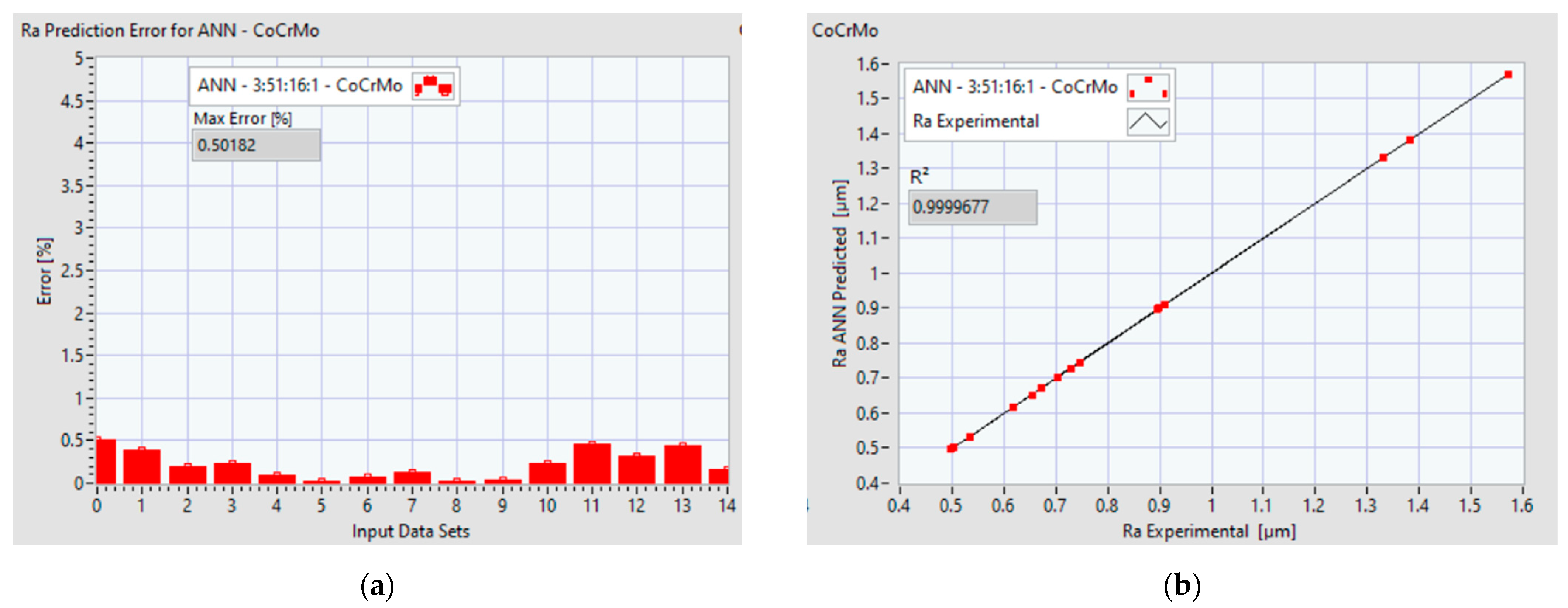
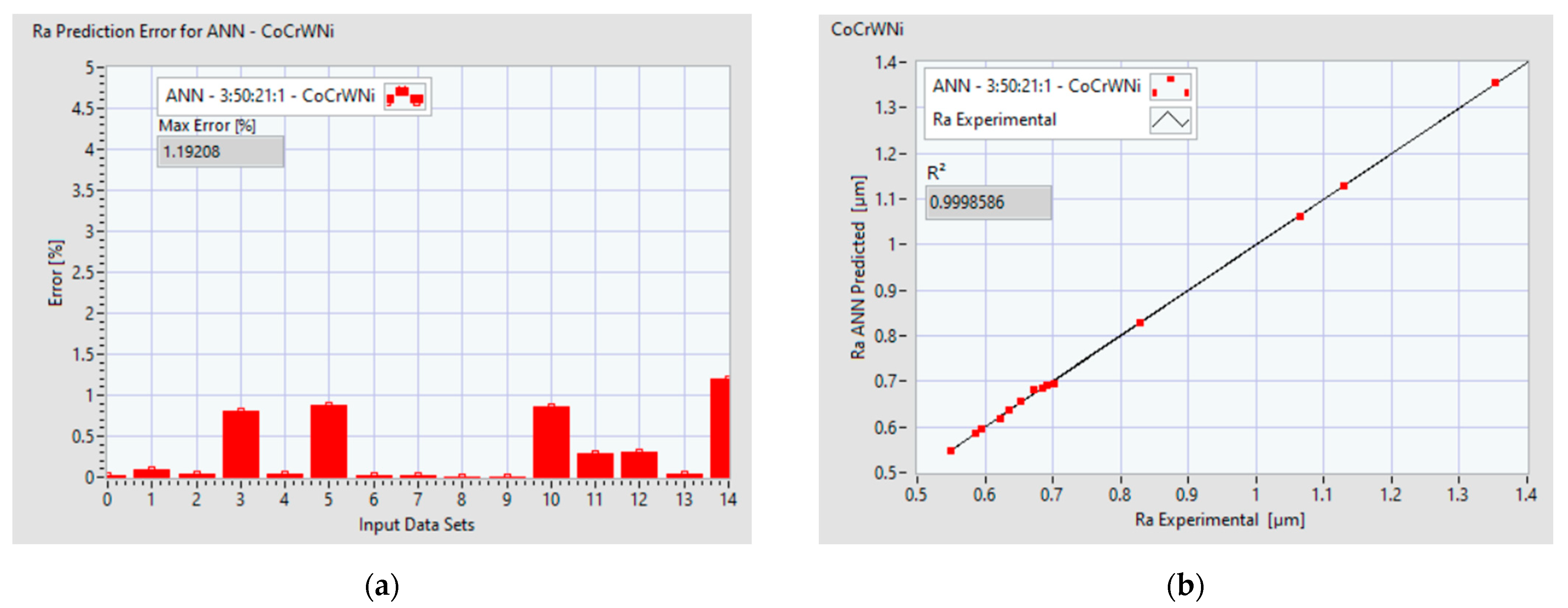
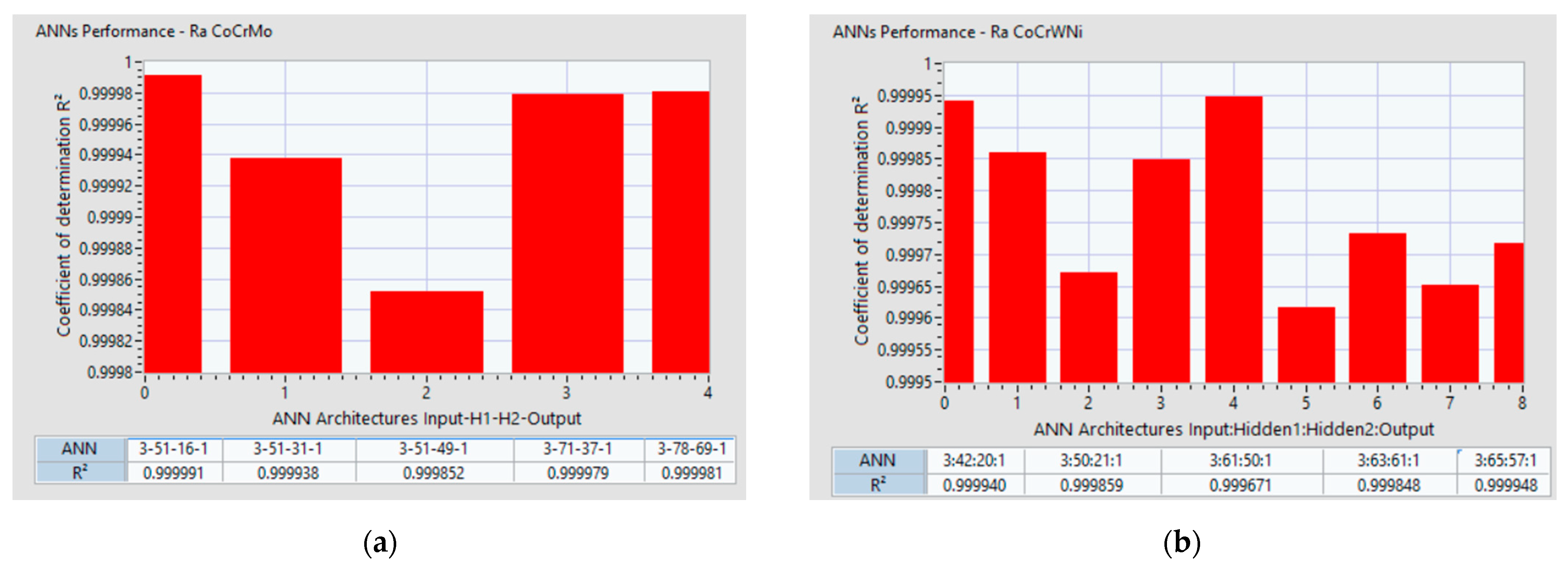


| Material | Chemical Elements (%) | ||||||||||
|---|---|---|---|---|---|---|---|---|---|---|---|
| Cr | Mo | Ni | Fe | C | Si | Mn | W | P | S | Co | |
| Co–28Cr–6Mo | 27.8 | 5.65 | 2.08 | 0.39 | 0.27 | 0.69 | 0.75 | 0.14 | 0.02 | 0.01 | Bal. |
| Co–20Cr–15W–10Ni | 19.68 | - | 10.13 | 2.11 | 0.09 | 0.72 | 1.04 | 15.1 | 0.015 | 0.022 | Bal. |
| Material | Hardness Type | Microhardness Measurements | Mean Value | ||||
|---|---|---|---|---|---|---|---|
| Co–28Cr–6Mo | HV 0.5 | 431 | 475 | 467 | 456 | 450 | 456 |
| HRC | 43.7 | 47.3 | 46.6 | 45.8 | 45.3 | 45.7 | |
| Co–20Cr–15W–10Ni | HV 0.5 | 370 | 366 | 345 | 351 | 345 | 355 |
| HRC | 37.7 | 37.3 | 35 | 35.6 | 35 | 36.1 | |
| Cutting Parameter | Symbols | Levels | ||
|---|---|---|---|---|
| −1 | 0 | +1 | ||
| Axial depth of cut (mm) | ap | 0.25 | 0.45 | 0.75 |
| Feed per tooth (mm/tooth) | fz | 0.02 | 0.032 | 0.05 |
| Cutting speed (m/min) | vc | 20 | 24.5 | 30 |
| Experiment No. | Process Variables Values | ||
|---|---|---|---|
| Axial Depth of Cut, ap (mm) | Feed per Tooth, fz (mm/tooth) | Cutting Speed, vc (m/min) | |
| 1 | 0.25 | 0.02 | 20 |
| 2 | 0.75 | 0.02 | 30 |
| 3 | 0.25 | 0.02 | 30 |
| 4 | 0.75 | 0.02 | 20 |
| 5 | 0.25 | 0.05 | 30 |
| 6 | 0.75 | 0.05 | 20 |
| 7 | 0.25 | 0.05 | 20 |
| 8 | 0.75 | 0.05 | 30 |
| 9 | 0.25 | 0.032 | 24.5 |
| 10 | 0.75 | 0.032 | 24.5 |
| 11 | 0.45 | 0.02 | 24.5 |
| 12 | 0.45 | 0.05 | 24.5 |
| 13 | 0.45 | 0.032 | 20 |
| 14 | 0.45 | 0.032 | 30 |
| 15 | 0.45 | 0.032 | 24.5 |
| Experiment No. | Process Variables Values | Ra Average Values ± u 1 (μm) | |||
|---|---|---|---|---|---|
| ap (mm) | fz (mm/tooth) | vc (m/min) | Co-20Cr-15W-10Ni | Co-28Cr-6Mo | |
| 1 | 0.25 | 0.02 | 20 | 0.595 ± 0.003 | 0.654 ± 0.026 |
| 2 | 0.75 | 0.02 | 30 | 0.586 ± 0.004 | 0.533 ± 0.016 |
| 3 | 0.25 | 0.02 | 30 | 0.548 ± 0.004 | 0.496 ± 0.032 |
| 4 | 0.75 | 0.02 | 20 | 0.652 ± 0.004 | 0.503 ± 0.034 |
| 5 | 0.25 | 0.05 | 30 | 1.471 ± 0.025 | 1.331 ± 0.006 |
| 6 | 0.75 | 0.05 | 20 | 0.702 ± 0.015 | 1.570 ± 0.017 |
| 7 | 0.25 | 0.05 | 20 | 1.354 ± 0.014 | 1.381 ± 0.041 |
| 8 | 0.75 | 0.05 | 30 | 1.130 ± 0.014 | 0.896 ± 0.087 |
| 9 | 0.25 | 0.032 | 24.5 | 0.636 ± 0.016 | 0.673 ± 0.024 |
| 10 | 0.75 | 0.032 | 24.5 | 0.829 ± 0.024 | 0.910 ± 0.008 |
| 11 | 0.45 | 0.02 | 24.5 | 0.623 ± 0.005 | 0.617 ± 0.009 |
| 12 | 0.45 | 0.05 | 24.5 | 1.066 ± 0.006 | 0.897 ± 0.025 |
| 13 | 0.45 | 0.032 | 20 | 0.684 ± 0.011 | 0.747 ± 0.042 |
| 14 | 0.45 | 0.032 | 30 | 0.692 ± 0.003 | 0.705 ± 0.018 |
| 15 | 0.45 | 0.032 | 24.5 | 0.672 ± 0.039 | 0.728 ± 0.034 |
| Model (Equation) | Type of Regression | Coefficient of Determination R2 |
|---|---|---|
| Equation (1) | Multiple linear regression | 0.7650 |
| Equation (3) | Response-surface regression | 0.8561 |
| Equation (5) | Nonlinear regression | 0.793799 |
| Model (Equation) | Type of Regression | Coefficient of Determination R2 |
|---|---|---|
| Equation (2) | Multiple linear regression | 0.7026 |
| Equation (4) | Response-surface regression | 0.93394 |
| Equation (6) | Nonlinear regression | 0.770015 |
Publisher’s Note: MDPI stays neutral with regard to jurisdictional claims in published maps and institutional affiliations. |
© 2021 by the authors. Licensee MDPI, Basel, Switzerland. This article is an open access article distributed under the terms and conditions of the Creative Commons Attribution (CC BY) license (https://creativecommons.org/licenses/by/4.0/).
Share and Cite
Dijmărescu, M.-R.; Abaza, B.F.; Voiculescu, I.; Dijmărescu, M.-C.; Ciocan, I. Surface Roughness Analysis and Prediction with an Artificial Neural Network Model for Dry Milling of Co–Cr Biomedical Alloys. Materials 2021, 14, 6361. https://doi.org/10.3390/ma14216361
Dijmărescu M-R, Abaza BF, Voiculescu I, Dijmărescu M-C, Ciocan I. Surface Roughness Analysis and Prediction with an Artificial Neural Network Model for Dry Milling of Co–Cr Biomedical Alloys. Materials. 2021; 14(21):6361. https://doi.org/10.3390/ma14216361
Chicago/Turabian StyleDijmărescu, Manuela-Roxana, Bogdan Felician Abaza, Ionelia Voiculescu, Maria-Cristina Dijmărescu, and Ion Ciocan. 2021. "Surface Roughness Analysis and Prediction with an Artificial Neural Network Model for Dry Milling of Co–Cr Biomedical Alloys" Materials 14, no. 21: 6361. https://doi.org/10.3390/ma14216361







